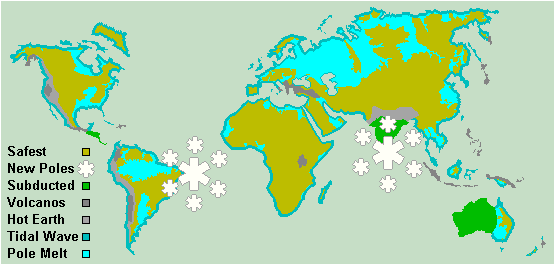
ZetaTalk: Safe Places
Note: written prior to July 15, 1995
There are many places on Earth that will be safer than others. Common sense can guide. If one reads the literature on past geological changes, and written and
spoken records on what occurred during past cataclysms, one can plot their course. Coast lines are dangerous, as the tidal waves will be immense. Subducting
plates or areas close to building mountains will be at risk. Buildings subject to earthquake damage should be avoided, and best of all is the least amount of
structure, as in tents or straw huts. Natural windbreaks are available, as valleys between hills.
- Areas subjected to mountain building in the recent past can be anticipated to be the subject of mountain building again during the coming pole shift. This
includes the Rockies west of the Continental Divide, as when the Pacific shortens, the subducting plate tucking under the west coast will not only create great
heaving and shifting in those surface areas above the subducting plate, it will also cause the Earth to heat up due to the friction. Likewise in the Himalayas,
but the mountains in Europe will not be any less safe than elsewhere in Europe, as the Atlantic will yaw and tend to pull Europe down in elevation. Thus, the
mountains in Europe may be safer than the lowlands which are subject to tidal influx. The spine of mountains running the length of South America is also
highly subject to trauma during pole shifts, in like manner to the Rockies. Here again the land west of the Continental Divide is the worst hit.
- In both the Americas the land east of the Continental Divide tends to go for a ride across the plains to the east. Heat from friction is a factor here, but heat
from compression is not present. The heat from friction is also closer to the surface and dissipates faster than heat generated from lower plate friction where
the heat builds until it can actually melt surface rock.
- Needless to say, caverns or man-made tunnels in traumatized mountain areas will not be safe. One need only visit Yosemite park to see the forces that will
be at play. The valley 2,000 feet below the surrounding cliffs, standing as a statement to the shearing force that took place in solid rock in the past. Will
caverns and man-made tunnels in older mountains be safe? Yes and no, as in each case the structure of the mountainous area and in particular the stability of
the cavern or tunnel ceiling must be analyzed. Each case stands alone. As humans run the risk of being trapped or crushed and could expect no rescue help
afterwards, this option is far less safe than other options.
- Water softens the blows both from the jolts of earthquakes and, if one is underwater, from flying debris. However, water will carry one with it, and the
swimmer or submarine may find themselves hundreds of miles inland when a tidal wave recedes, or far from any shore.


